Final report for GS18-180
Project Information
Plum curculio (PC), Conotrachelus nenuphar (Herbst), is a key pest in Southeastern peach production that infests fruit and decreases yield. Currently, peach growers mainly follow the calendar-based spray programs and heavily rely on repeated applications of conventional broad-spectrum insecticides for PC management. However, frequent insecticide applications can cause non-target effects (e.g. eliminating beneficial insects), insecticide resistance and adverse effects on the environments (e.g. insecticide runoff and drift). Thus, there is a need for the development of more sustainable approaches for PC management.
To establish a sustainable PC management program, understanding the pest’s behavior is important. A better understanding of PC behavior will facilitate the development of sustainable PC management programs that spatio-temporally target PC infestation hotspots within a peach orchard. By precisely targeting PC infestation hotspots, the sustainable PC management programs can not only reduce insecticide input, but also mitigate the adverse effects caused by repeated insecticide applications. The goal of this project was to facilitate the development of sustainable PC management programs for Southeastern peaches by deciphering PC behavior in peach orchards over time. We intensively monitored the distribution and movement of PC in peach orchards in Georgia throughout the season. We found that PC in Southeastern peaches did not exhibit the “edge effect”, where more PC are present next to a forested border than in the center of the orchard. In addition, we discovered that PC tended to fly instead of walking within the orchard during midseason.
Our results suggest that PC in Southeastern peaches do not exhibit the edge effect and PC can potentially overwinter within the orchard instead of in the adjacent forest. These findings will lead to future research further looking into where in an orchard PC overwinter for new potential management tactics targeting PC prior to the following season. The finding of PC’s tendency to fly during midseason provides information on how monitoring traps should be deployed to efficiently capture PC and shows that during midseason, using insecticide application methods that can target flying PC in the canopies is important.
Objective 1: To investigate plum curculio dispersal patterns form the forested border and distribution within the adjacent peach orchard over time.
Objective 2: To determine primary dispersal mode and behavior (flight or walking) of plum curculio within a peach orchard throughout the season.
Research
Objective 1: To investigate plum curculio dispersal patterns from the forested border and distribution within the adjacent peach orchard over time.
We conducted this field study in two peach orchards located in Byron, GA from mid-March to mid-October in 2019. At each experimental site, we installed circle trunk traps (Great Lakes IPM, Inc., Vestaburg, MI) (Fig.1) on 12 exterior (perimeter) peach trees and 12 interior peach trees of the orchard (Fig. 2). The circle trunk traps placed around the peach tree trunk block and collect adult PC walking up to the trees. Since PC can also fly, besides collecting PC walking up to the trees, we also sampled PC flying to the tree canopies by conducting “beat sampling”, where we randomly selected five terminal branches from each tree installed with the trunk traps, and gently jarred the terminal branches with a foam bat and collected PC falling from the terminal branches with a “beat sheet” (Fig. 3). We monitored the distribution and movement of the PC adults within each orchard over time by checking the circle trunk traps and conducting beat sampling 1-3 times a week.
Plum curculio counts from the same sampling week were pooled together for statistical analyses. For each sampling week, we compared the numbers of PC captured in the exterior peach trees with those captured in the interior peach trees with t-test. We determined whether PC exhibited the “edge effect”, where more PC are present next to a forested border (exterior trees) than in the center of the orchard (interior trees).
Objective 2: To determine primary dispersal mode and behavior (flight or walking) of plum curculio within a peach orchard throughout the season.
We conducted this research at the same sites mentioned in objective 1 from mid-March to mid-October in 2019. On each sampling day when circle trunk traps were assessed and beat samples were taken from each tree installed with the trunk traps for objective 1, we also performed beat sampling from the directly adjacent tree without trunk traps for each sampling unit (the tree installed with the circle trunk traps and its adjacent tree). In each sampling unit, we obtained the number of PC walking to the tree by subtracting the number of PC collected by beat sampling from the tree installed with the circle trunk traps from the number of PC collected by beat sampling from the adjacent tree. Thus, the number of PC flying to the tree is the number of PC collected by beat sampling from the tree installed with the circle trunk traps. We performed paired t-tests to compare the numbers of PC flying and walking on each sampling date.
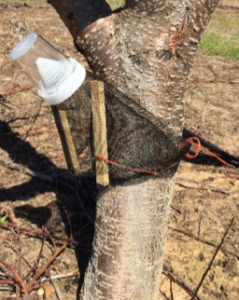
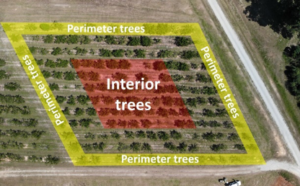
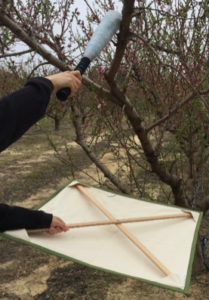
Objective 1: Throughout 30 sampling weeks, we did not find any sampling weeks where there were more PC in the exterior trees than interior trees (Fig. 4). Our findings indicate that there was no edge effect, suggesting that a significant proportion of PC may overwinter within orchards instead of in the adjacent forest. This phenomenon was also reported by previous research conducted in Alabama peaches.
Objective 2: The sampling days with significantly more flying PC than walking PC occurred during June 10th to the beginning of July (Fig. 5). Except for one sampling day early in the season in orchard 2, there were no other sampling days with significantly more walking PC than flying PC throughout the season (Fig. 5). According to our studies, plum curculio exhibited significantly higher tendency to fly than walk during midseason, whereas PC did not show significantly higher tendency to walk than fly throughout the season except for one sampling day early in the season. Plum curculio’s tendency to fly during midseason shows the importance of using sampling methods that can capture flying PC for efficiently and accurately monitoring PC during midseason.
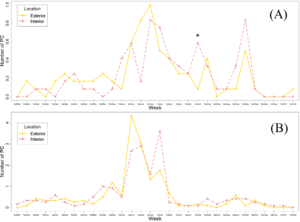
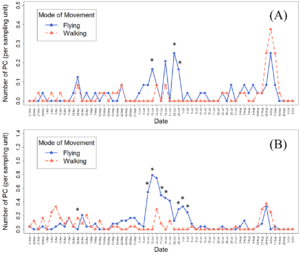
Educational & Outreach Activities
Participation Summary:
The results of our research were presented at the 2019 Entomological Society of America’s annual meeting in St. Louis, MO in November 2019. Two presentations, “Assessment of plum curculio activity in Southeastern peach orchards” (Tzu-Chin Liu and Brett Blaauw) and “The not so peachy side of research in southeastern fruit orchards” (Brett Blaauw and Tzu-Chin Liu) were presented at this professional conference.
In January 2020, Brett Blaauw presented the results of this project to growers at the Southeast Regional Fruit and Vegetable Conference in Savannah, GA. Brett Blaauw has visited approximately six key peach growers in the Southeast to discuss the progress of this research project.
Project Outcomes
Our studies suggest that PC in Southeastern peach orchards do not exhibit edge effect and PC are likely to overwinter within peach orchards. These findings will lead to future research further looking into PC’s activity within a peach orchard. To provide Southeastern peach growers with novel PC management tactics, future studies should identify where in an orchard PC overwinter for new potential management tactics targeting PC prior to the following season. Managing PC before they become active again in the following season may benefit growers by lowering the overall pest pressure of PC in the beginning of the following season, and thus reduces peach yield loss and lowers inputs required for PC management during the season.
Plum curculio’s tendency to fly during midseason shows the importance of using sampling methods that can capture flying PC for efficiently and accurately monitoring PC during midseason. In addition, using insecticide application methods that can target flying PC in the canopies is important during midseason. Although there was only one sampling day with more walking PC than flying PC throughout the season in two research orchards, approximately 34% of the PC sampled in objective 2 were walking PC. Hence, future studies should investigate whether trunk applications targeting walking PC would reduce PC damage on peaches. Since trunk applications pose less insecticide drift concerns compared to direct applications to tree canopies, adopting trunk applications into PC management programs may potentially reduce the frequency of direct canopy applications and reduce overall adverse effects caused by insecticide applications on the environments.
Previous research conducted in Canadian apples suggest that PC migrate from the woodlots adjacent to the orchard before moving into the interior of the orchard. As such, plum curculios in the northern region of the USA are thought to exhibit an “edge effect”, where more PC are present next to a forested border than in the center of the orchard. Exploitation of this behavior allows for border-targets application of insecticides that may potentially significantly reduce the amount of insecticides applied to an orchard. Unfortunately, in terms of the short-term outcome of our research, our results suggest that PC in Southeastern peaches do not exhibit an edge effect and PC may actually overwinter within the orchard instead of in the adjacent forest. As such, these findings will lead to future research further looking into where in an orchard PC overwinter for new potential management tactics targeting PC prior to the following season.
In addition, previous research conducted in Massachusetts apples revealed that PC tended to fly at air temperatures above and equal to 20°C, whereas they tended to walk at air temperatures below 20°C. With cooler temperatures in the Northeast USA during spring migration, monitoring of PC could be accurately done using circle trunk traps to intercept PC crawling up apple trunks. In contrast, this project determined that PC tended to fly throughout the season, which provides information on how monitoring traps should be deployed to efficiently capture PC and shows that during midseason, using insecticide application methods that can target flying PC in the canopies may be important.
Our knowledge of PC behavior changed unexpectedly compared to what was expected from PC behavior in the Northeast. While this is initially disappointing, we have established that Southeastern peach growers cannot rely on recommendations from other regions. Management of PC may not be unique to the Southeast, but we are going to need to identify a unique strategy for sustainably managing them here.
In progress.